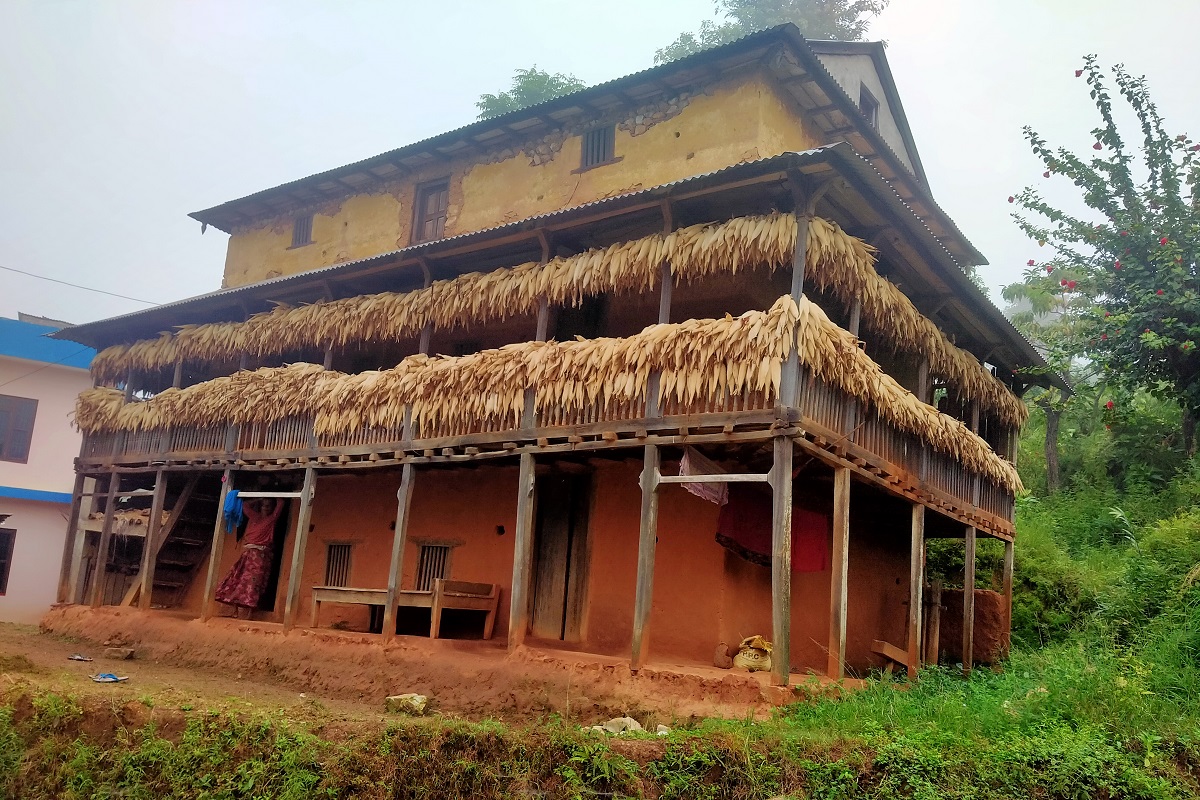
Maize (Zea mays L.) is one of the principal staple crops cultivated in the hilly areas of Far Western Nepal, including Baitadi, Dadeldhura, Bajhang, and Darchula districts. The region’s rugged topography and monsoonal climate pose unique challenges for post- harvest storage. Farmers have developed traditional and climate-adapted storage techniques, among which the Thangro system remains dominant. Thangro, constructed from wooden poles and bamboo, allows cobs to dry naturally while preventing fungal decay and insect infestation. Storage usually starts in Bhadra
(August–September) and continues for at least a month for proper drying, while maize can be safely preserved up to Chaitra (March–April) for household consumption. This study documents traditional maize storage practices, evaluates their functional efficiency, and identifies opportunities for integrating indigenous knowledge with modern post-harvest innovations to reduce losses and enhance food security in hilly regions.
INTRODUCTION
The hills of Far Western Nepal are characterized by steep slopes, variable rainfall, and limited access to improved storage infrastructure. Maize, being a rain-fed crop, is harvested during the monsoon transition period when drying is difficult, leading to mold, weevil attack, and loss of seed quality. Farmers have, over generations, developed indigenous grain storage systems using local materials and wisdom suited to the topography and climate.
Among them, the Thangro structure, locally known as Gothi Thangro or Makai Thangro, remains a key component of traditional post-harvest management. Documentation and scientific evaluation of such systems are essential for promoting sustainable food preservation and reducing post-harvest loss in the mountain economy.


MATERIALS AND METHODS :
The study was conducted in Baitadi, Dadeldhura, and Darchula districts during the 2024 maize harvesting period. Data were collected through: Field visits and observations of traditional storage structures. Interviews with 40 local farmers (both men and women). Key informant discussions with senior farmers and agricultural technicians. Photography and structural measurement of Thangro units. Secondary data were obtained from MoALD reports, FAO publications, and NARC post- harvest studies. Observations were analyzed descriptively to compare storage types, advantages, and challenges.
RESULTS AND DISCUSSION :
1. Thangro Storage System
Thangro is a cylindrical or square structure made of four strong wooden poles and interwoven bamboo or branches. Maize cobs (with husk) are tied in bundles and stacked around the frame, forming a ventilated column. The top is covered with thatch or plastic sheet to prevent rainfall.
Key Features:
Timing: Storage begins in Bhadra and remains for at least one month for complete drying.
Duration: Well-dried maize remains safe up to Chaitra.
Function: Natural airflow promotes gradual drying, reducing fungal attack.
Pest control: Husk-covered cobs minimize weevil and moth infestation.
Cultural value: Thangro is a symbol of abundance and household pride.
2. Other Storage Practices
Bhakari, Earthen or bamboo bins Storage of shelled maize grains Susceptible to moisture absorption
Ghyampo / Ghyampo Dhakro, Earthen pot or wooden box Seed maize storage Limited capacity
Hanging bundles (Chhatma),Hung above kitchen fireplace Smoke acts as fumigant Small-scale, for seed only
3. Advantages of Traditional Storage
Locally available and low-cost materials.
Maintains seed germination and taste.
Prevents aflatoxin contamination through natural drying.
Culturally sustainable and gender-inclusive (women-led maintenance).
4. Limitations and Losses
Exposure to rain if top covering is weak.
Rodent attack at ground level.
Labor-intensive setup.
Reduced durability of bamboo with time.
5. Scientific Perspective
Temperature and humidity monitoring showed that Thangro maintained 12–14% grain moisture after 30–35 days of storage, compared to 18–20% in Bhakari, indicating its efficiency in reducing fungal growth. Use of ash, neem leaves, and plant-based repellents further improved pest control.
Such indigenous systems represent low-cost, eco-friendly storage models adaptable to mountain agriculture.
CONCLUSION :
Traditional maize storage systems like Thangro are not only practical but environmentally sustainable. They conserve post-harvest grains effectively under hilly climatic conditions and embody centuries of farmer innovation. To strengthen their contribution:
Provide technical support to improve roof covering and rodent-proof bases.
Integrate modern pest repellents and solar dryers to complement traditional drying.
Encourage community-level training on scientific grain drying and preservation.
Promote documentation and curriculum inclusion of local storage systems.
Recognize and incentivize women-led indigenous knowledge in food security
ACKNOWLEDGEMENTS
Poster prepared for the course Agrobiodiversity Conservation and Climate Change. I am thankful to the Department of Agri-botany and Conservation Ecology, AFU, for valuable guidance and to the farmers of farwestern hills for sharing their indigenous wisdom and field experiences.
KEY REFRENCES :
MoALD. (2019). Statistical Information on Nepalese Agriculture (2018/19).
NARC. (2020). Traditional Grain Storage Practices in Hill Regions of Nepal.
FAO. (2018). Reducing Post-Harvest Losses in Mountain Agriculture.
Ghimire, R. et al. (2022). Post-Harvest Challenges in Hill Maize Systems of Nepal. Journal
of Mountain Agriculture, 12(2), 45–53.
Bhandari, G., Achhami, B. B., Karki, T. B., Bhandari, B., & Bhandari, G. (2015). Survey
on maize post-harvest losses and its management practices in the western hills of Nepal.
Journal of Maize Research and Development, 1(1), 98-105.
Pokhrel, P. (Year). Postharvest Handling and Prevalence of Aflatoxin Contamination in
Nepalese Maize Produce. Journal of Food Science and Technology Nepal.
Bhandari, G., Adhikari, B. N., Bhandari, B., Adhikari, J. B., Kaduwal, S., & Pokhrel, P.
(2023). Storability of Different Hermetic Bags on Seed Quality Attributes of Maize in
Khumaltar, Lalitpur. Agronomy Journal of Nepal, 7, 36-42.
फोटो-सामाजिक संजाल









